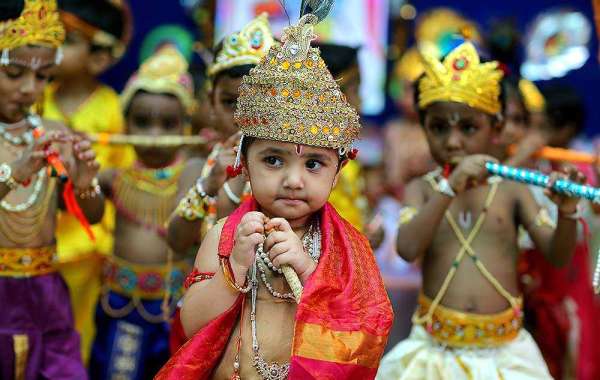
About the Shri Krishna Janmasthan Temple Mathura
Shri Krishna Janmasthan Temple, also known as Shri Krishna Janmabhoomi temple, is centred on the prison cell where Lord Krishna's parents, Mata Devaki and Vasudeva, were imprisoned by his wicked uncle Kansa.
Aside from the prison cell, the Krishna Janmasthan Temple contains other temples devoted to the god. The holy ambience and purity of the temple infuse the heart with confidence that this is the spot where Lord Krishna revealed himself.
#Trivia: Several kings destroyed it numerous times before being rebuilt with financial assistance from industrialists.
The Krishna Janmasthan Temple sees heavy footfall during holidays such as Janmashtami (The birthday of Lord Krishna), Basant Panchami, Holi, and Diwali.
#Note: Cameras aren't allowed due to security purposes. Most Mathura temples prohibit cell phones and cameras, therefore try to avoid them when visiting any temple.
Location of the Shri Krishna Janmasthan Temple in Mathura
The temple stands at Deeg Marg, Near Deeg Gate Chauraha, Mathura.
History of Shri Krishna Janmasthan Temple Mathura
Krishna Janmabhoomi holds a special place in the hearts and souls of Hindus since it is Lord Krishna's birthplace. The tyrant King Kansa, Krishna's maternal uncle, ruled Mathura during his birth.
#Trivia- According to legend, Akashvaani (a heavenly declaration) foretold Kansa's death at the hands of Devaki's eighth child.
In response to the announcement, he imprisoned Shri Vasudeva and Mata Devaki and arranged for the murder of all of her children. However, Devaki gave birth to Lord Krishna at midnight during her eighth month of pregnancy. All of the jail doors were left open that night due to a miracle performed by Lord Vishnu. Vasudeva brought the infant in a basket over the Yamuna after his birth.
nteresting historical facts about Shri Krishna Janmasthan Temple Mathura
The Sri Krishna Janmasthan Temple was built nearly 5000 years ago by Vajranabha, Krishna's great-grandson.
Then, around 400 AD, under the reign of Chandragupta Vikramaditya, it was reconstructed.
Mahmud of Ghazni destroyed it in 1017 AD.
Raja Dhurpet Dev Janjua, the Emperor of Mathura, built the temple for the third time in 1150 AD.
It was demolished in the 16th century by Sikandar Lodi, Sultanate of Delhi.
Raja Veer Singh Bundela restored it with INR 3.3 million 125 years later, during the reign of Jahangir.
In 1669 AD, Aurangzeb demolished it once more and replaced it with a masjid.
When Britishers took over the city of Mathura in 1815, the temple area was auctioned off.
On February 21, 1951, late Mahamana Pandit Madan Mohan Malaviya took the initiative to rebuild the temple by founding the 'Sri Krishna Janma Bhoomi Trust.'
The building was ultimately constructed due to the tireless efforts of many people.
Structures inside the Shri Krishna Janmasthan Temple Complex
The Sri Krishna Janmasthan Temple houses the Keshavdev temple, the Garbha Griha shrine, and the Bhagavata Bhavan.
Keshavdev Temple: Ramkrishna Dalmia constructed the Keshavdev Temple south of the Shahi Eidgah in honour of his mother, Jathia Devi Dalmia. The construction began on June 29, 1957, and was dedicated on September 6, 1958, by Hanuman Prasad Poddar.
Garbha Griha Shrine: It is the location of Krishna's prison cell, where he was born. You can see a marble pavilion and an underground prison cell with a large veranda on the site. A temple devoted to the eight-handed goddess Yogmaya stands nearby.
Bhagvat Bhavan: The temple is dedicated to Srimad Bhagavata, built on February 11, 1965.
It has five shrines: the main shrine has six-foot-tall statues of Radha and Krishna, with the shrine of Balarama, Subhadra, and Jagannath on the right, the temple of Rama Lakshman and Sita on the left, Garuda Stambha and Chaitanya Mahaprabhu in front of Jagannatha shrine, and Hanuman in front of Ram shrine, the Durga temple, and the Shivalinga temple.
The paintings on the assembly hall's ceiling, walls, and pillars represent Krishna and his disciples. In addition, you can see inscriptions of the verses of the Bhagavad Gita on the walls of the circumambulation walkway.
Potra Kund: Potra Kund or Pavitra Kund, a vast and deep tiered water tank in the southeast of the Janmasthan temple, holds significance as the first bathing site of infant Krishna following his birth. Mahadji Scindia constructed the tank stairs in 1782. In 1850, his ancestors repaired them.
Book a Seva with temple today sitting at your home.




